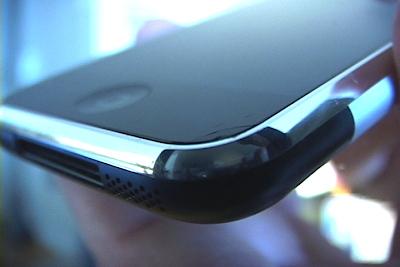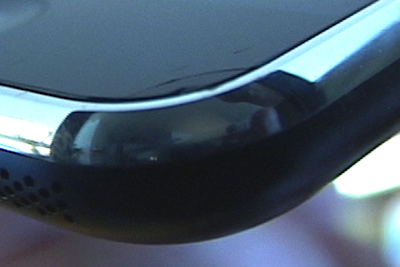So I've had my iPhone for a few weeks now, and I've had a chance to travel with, accidentally lock and drop it. Thought I'd report on the state of the iPhone after long-term, heavy use.
AT&T and My SIM Card
One of the most common questions I got after my initial iPhone review was how AT&T was compared to Sprint. Mind you, I have grown to absolutely loathe Sprint and their treatment of long-term customers, of which I had been a member. Pretty much as long as I could ignore AT&T I figured I'd be happy. And if I did have to call them for some reason, as long as they weren't complete assholes to me and didn't try to charge me for stuff I didn't buy, again, happy camper. Well, I did have to call them.
At some point, while fiddling around with my iPhone's settings, I decided to try locking the SIM card. Locking the SIM is a security precaution: Should your iPhone wind up in nefarious hands, the SIM card is password protected. What I didn't know was that, out of the box, the SIM card is already password protected with a password known only to AT&T, initially. So when I tried to change the password, it asked me for the existing one. When I provided the wrong one, it locked me out as it's meant to do. Shit.
From then on the phone refused to let me make any calls or use the Edge network. I had to go onto a regular old computer to go to AT&T's website. Here I tried to log into my account, which I apparently had not set up yet. I had sort of assumed this had been set up for me when I activated my phone, but no. Setting up my AT&T web account required going to the site and doing so. Unfortunately, this didn't get me very far, though it did get me to a forum article that described the problem I was having and its solution. In the article was a link to an AT&T utility that would reset or send me the SIM card password. This tool worked perfectly except for one fatal flaw: It sent my SIM card password to my phone via SMS text. Uh, guys... That's not gonna cut it...
Loathe as I was to contact AT&T over all this — or customer service in general, for that matter — looks like that's what I was going to have to do. So I gave them a call (on a friend's cell phone, of course). After navigating the inevitable voice-based menus, I was told that my wait-time to speak to customer service would be two minutes. Not bad considering Sprint was usually upwards of twenty. In about a minute, though, I was speaking to a human. Not only that, but said human knew exactly what I was talking about, and how to fix it. He stayed on the phone with me while I entered the old password and set a new one, and after that everything was right back to normal. The whole call took under five minutes. Amazing!
I've heard AT&T has been making a great effort to improve customer service. And, while I still hope to avoid them in the future, I'll be a lot less resistant to giving them a call based on this recent experience. I can't say the same for their website, though. Finding info there seemed to be quite a painful affair. But, so far anyway, we're light years ahead of Sprint.
Travel
Over the last few weeks I've also had the opportunity to do some light traveling and testing of AT&T's cellular coverage in remote areas. I drove to the farmlands of upstate New York this past weekend, and I used Google maps for just about everything. I had taken along a paper map as well, in case I couldn't get cell phone reception, but I rarely needed it. Google Maps just freakin' rocks, and even in farm country, the AT&T network seemed to hold up pretty well. Not perfectly, mind you — there were certainly a few spots where I had spotty coverage, or none at all. But considering where I was, I was pleasantly surprised at my level of coverage.
Drops
One major bummer happened along my travels: I dropped my iPhone for the first time. I had gone swimming and brought the thing along with me. After my dip I went to pick the iPhone up off the pool chair where I'd left it — with a shirt to keep it from getting wet — and it slipped out of my hands and landed on the concrete, face down. The indestructibility of that glass is near-legendary at this point, and I'd only dropped it from a height of maybe three or four feet, so I honestly wasn't even worried. Imagine my horror when I got back to my hotel room and discovered not only scratches, but a small crack in the lower right hand corner of the glass. Yup. A crack. Fortunately, this is nowhere near the touch-sensitive areas of the screen, and the phone continues to work perfectly.

iPhone Glass: Crack-Resistance Over-Stated?
(click image for larger view)
I've since managed to drop it from full standing height face down onto a hardwood floor, and it has emerged unscathed, so I don't think my first drop was typical. Still, dropping the iPhone can indeed crack the glass, so if you're worried, or prone to dropping phones a lot, and you want to keep your iPhone in pristine condition, you may want to consider getting a case for it. Me, I'm trying to just accept the fact that the phone will not stay perfect forever, and that shit happens. After all, what's a few scrapes and scuffs, right? Builds character!
Yeah... Okay... Whatever...

iPhone Glass Crack Detail: Not So Bad, I Guess
(click image for larger view)
Anyway, I still love the damn thing. In fact, I have to say, maybe the most frustrating thing about it is how much I like it. It's the reason I bring it to the pool. It's the reason I drop it so much. Hell, it's even the reason I locked up the SIM card. I just can't seem to leave it alone.
So, yeah, still happy, cracks and all.
UPDATE:
iPhone Atlas has posted an article on options for cracked iPhone screens. It's pretty much what I'd expected, but what I didn't know is that Apple has a repair program for the iPhone, and they'll reportedly repair any iPhone for a flat rate of $199 for the 4GB model or $249 for the 8GB model. Why the price is different for the 8GB model is beyond me, but there you have it. Thought I'd let you all know.







